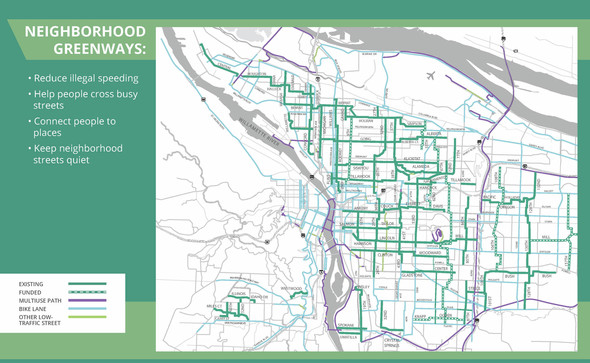 News Media contact:
Hannah Schafer
(971) 235-8472
hannah.schafer@portlandoregon.gov
@pbotinfo
News Blog:
Need fresh air? Looking for a safe place to get moving? Portland has 118 miles of streets built just for you
PBOT’s 2020 Neighborhood Greenways Report shows the opportunities (and challenges) facing Portland’s greenways during the Covid-19 public health crisis and beyond
As part of PBOT's Covid-19 response, 118 miles of city streets were designated as “Slow Streets.”
(Nov. 17, 2020) Looking for a silver lining in 2020? This year there are more streets that give priority to people walking, biking, rolling, and strolling than ever before. For the past two years, the Portland Bureau of Transportation (PBOT) has expanded and improved Portland’s neighborhood greenway network with new projects and safety upgrades to existing infrastructure. Additionally, as part of PBOT’s pandemic response, the bureau has converted the entire neighborhood greenway network and an additional 15 miles of low-traffic streets into “local access only” to create more space for Portlanders of all ages to get fresh air, move, and play during the Covid-19 public health crisis.
PBOT’s 2020 Neighborhood Greenways Status Report, released today, shows the opportunities (and challenges) facing Portland’s greenways during the Covid-19 pandemic and beyond.
Neighborhood greenways form the backbone of the city’s Safe Routes to School network. They connect neighborhoods, parks, schools, and business districts. There are 103 miles of neighborhood greenways in every part of the city. They often run parallel to busier streets, providing a quiet place for families to walk and bike. Mapping apps like Waze sometimes direct drivers through residential streets to avoid traffic. Neighborhood greenways interrupt these traffic patterns by preventing cut-through traffic.
In response to the Covid-19 health crisis, PBOT launched the Safe Streets Initiative. As part of this initiative, 118 miles of city streets were designated as “Slow Streets.” PBOT put up signs and barrels throughout the city to make these Slow Streets “local access only.” These have become a common sight around the city.

Portlanders have been enthusiastic about these installations, but more work needs to be done to improve and build greenways throughout the city. The 2020 Greenways Status Report provides recommendations on how to keep traffic volume low and speeds slow using a mix of traffic diversion, speed bumps, protected crossings, and better visibility at intersections. The report also recommends that PBOT continue helping Portlanders connect to neighborhood greenways through outreach to residents. This includes community-led, city-sponsored projects such as the recent Greenway Shuffle dance challenge created in partnership with Hip Hop Soulsation Academy. Focused marketing campaigns, such as the successful “Go by Greenways” in East Portland, also help people feel welcome and safe on greenways.
Between 2019 and 2022, PBOT will have added 25 miles of new neighborhood greenways in East Portland. This expansion already creates more ways for people to explore the city and get to essential services without using a car. The new 130s Neighborhood Greenway, for example, provides a 5-mile north-south connection between the I-84 multiuse path and the Springwater Corridor Trail. This greenway connects several East Portland neighborhoods and provides better access to nine schools and five parks.
Learn more about Portland’s Neighborhood Greenways and read the 2020 Neighborhood Greenways Status Report at www.neighborhoodgreenways.org.

The Portland Bureau of Transportation (PBOT) is the steward of the city’s transportation system, and a community partner in shaping a livable city. We plan, build, manage, and maintain an effective and safe transportation system that provides access and mobility. www.portlandoregon.gov/transportation
|